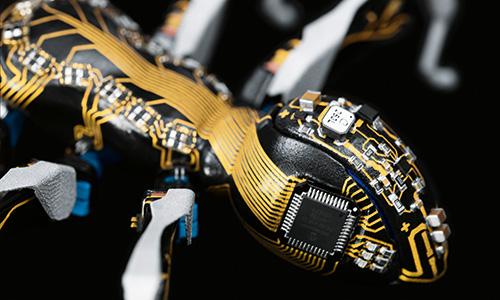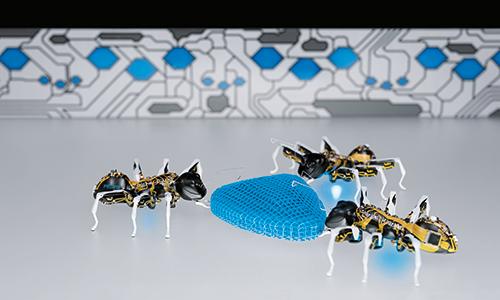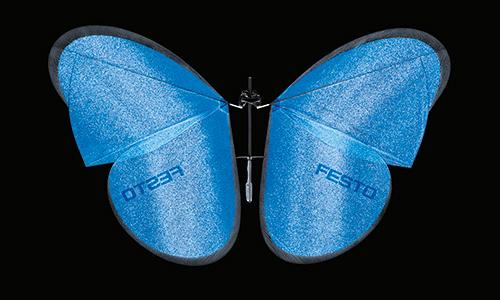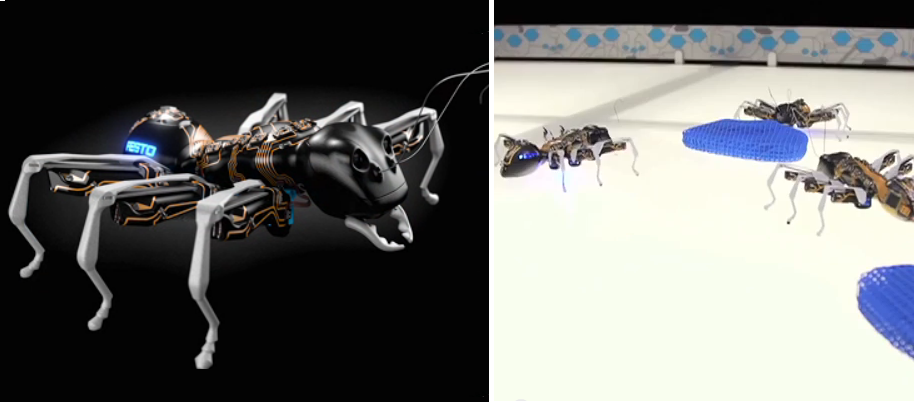Taking all those sci-fi stories of robot armies to the next — and more realistic level — Festo has created one on the formicidae level with the BionicANTS, as well as their robotic, lightweight eMotionButterflies. Both creations are soon to be on display at the Hannover Fair in Germany April 13-17.
Just imagine 3D printed colonies of ants, commanded to work together just as their live counterparts do naturally. Not only are they highly functional, they are stunningly beautiful with intricate  details and vibrant color — almost jewel-like in their aesthetics, thanks to the use of 3D MID technology on laser-sintered shaped body parts. They are also powered by electronics, and part of their beauty is actually lent due to the strategic design of the golden-hued electrical components, which cause the 3D printed ants to function in myriad ways.
details and vibrant color — almost jewel-like in their aesthetics, thanks to the use of 3D MID technology on laser-sintered shaped body parts. They are also powered by electronics, and part of their beauty is actually lent due to the strategic design of the golden-hued electrical components, which cause the 3D printed ants to function in myriad ways.
 Festo, with 16,700 employees in 176 countries, is not a company that bandies the words ‘high-tech’ and ‘innovative’ about as mindless marketing spin. They are the real deal, creating over 100 innovations of their own per year, with over 2,900 patents around the world.
Festo, with 16,700 employees in 176 countries, is not a company that bandies the words ‘high-tech’ and ‘innovative’ about as mindless marketing spin. They are the real deal, creating over 100 innovations of their own per year, with over 2,900 patents around the world.
While it doesn’t take genius to know that patterning many scientific and automated innovations after nature is a sensible idea, it can indeed take some brilliance to put that into action. Festo has without doubt done so with their Bionic Learning Network, meant to be an experimental and learning experience from nature in corroboration between Festo and multiple other institutions and companies.
The BionicANTS function with “clear tasks.” Shortening their name to the useful and appropriate ANTS, which stands for Autonomous Networking Technologies, the little 3D printed beauties are able to coordinate and communicate with one another for their work at hand thanks to “complex control algorithms.”
“They communicate with each other and coordinate both their actions and movements,” explains Dr-Ing Heinrich Frontzek, Festo’s head of corporate communication and future concepts. “Each ant makes its decisions autonomously, but in doing so is always subordinate to the common objective and thereby plays its part towards solving the task at hand.”
The BionicANTS, meant to show “cooperative behaviour based on a natural model,” institute not only the amazingly functional but delicate bodies but also their behavior which is forever a fascination with humans, as they are one of the most organized living creatures on Earth.
Using piezo power (electricity generated with piezoelectric sensors) to cause those six delicate legs to locomote, the BionicANTS also have actual cameras built into their heads so that they are able to ‘see’ objects in front of them and study them.
How does Festo use this in their mission to reach a goal of “maximum productivity and competitiveness of [their] customers in factory and process automation?” Quite simply, they see this as a parallel for factories’ systems that will use robotic artificial intelligence that can adapt in different situations.
Continuing in the naturalistic vein, the eMotionButterflies have a surreal quality — part futuristic sci-fi movie and part Disneyland — demonstrating a Festo focus and fascination with flight and virtual reality — and what we can do with it. Using ultra-lightweight material to construct  these butterflies, they are an example of innovations in miniature with GPS and infrared cameras which are responsible for allowing the communicative ‘butterflies’ to flit about gracefully without knocking into each other.
these butterflies, they are an example of innovations in miniature with GPS and infrared cameras which are responsible for allowing the communicative ‘butterflies’ to flit about gracefully without knocking into each other.
“The eMotionButterflies impress with an intelligently employed mechanical system and the smallest possible power units in the tightest space,” the Festo team states. “The reduced use of materials enables the true-to-nature flying behavior”
With a network of cameras connected to a computer system, the butterflies are coordinated. What is the real world application for this? Festo, always looking out for their clients, sees this as having potential for the ‘networked’ smart factory of the future with monitoring systems that work to guide.
Also well-worth checking out will be Festo’s gripping system taking more notes from nature — modeled from the chameleon’s tongue. The uber-futuristic design can adapt to grip objects of various shapes and sizes. The FlexShapeGripper can grasp and release a variety of objects due to the creation of a water-filled silicone cap which encompasses its cargo.
Do you see these studies of nature translated into technology as having real world applications in a factory situation, as an example? Tell us your thoughts in the 3D Printed Communicating BionicAnts forum thread over at 3DPB.com. Check out a video of the BionicANTS below:
Subscribe to Our Email Newsletter
Stay up-to-date on all the latest news from the 3D printing industry and receive information and offers from third party vendors.
Print Services
Upload your 3D Models and get them printed quickly and efficiently.
You May Also Like
The Dental Additive Manufacturing Market Could Nearly Double by 2033, According to AM Research
According to an AM Research report from 2024, the medical device industry, specifically in dentistry, prosthetics, and audiology, is expected to see significant growth as these segments continue to benefit from...
Heating Up: 3D Systems’ Scott Green Discusses 3D Printing’s Potential in the Data Center Industry
The relentless rise of NVIDIA, the steadily increasing pledges of major private and public investments in national infrastructure projects around the world, and the general cultural obsession with AI have...
AM Research Webinar Explores Continuum’s Sustainable Metal Additive Manufacturing Powders
Metal additive manufacturing (AM) powder supplier Continuum Powders is working to develop solutions that empower industries to reduce waste and optimize their resources. An independent life cycle assessment (LCA) of...
3D Printed Footwear Startup Koobz Lands $7.2M in Seed Round
California-based Koobz is focused on reshoring the U.S. footwear supply chain with advanced manufacturing processes, including 3D printing. The startup just announced that it has added $6 million to its...

































